Lyli Herse, 1928 – 2018
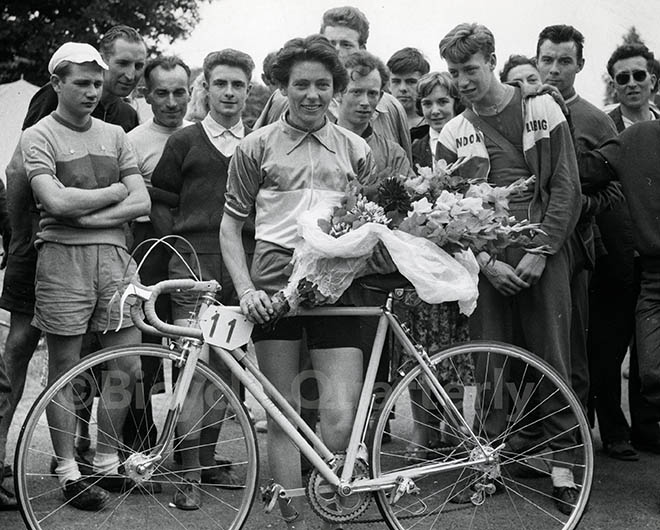
Lyli Herse would have turned 90 years old today (January 6) – and this post was written to celebrate her life that has inspired so many of us. But alas, I have to report instead that Lyli died on Thursday after a very short illness. Despite the great sadness of losing her, let’s celebrate her anyway, because that is what she would have wanted.
Until just a few days ago, she remained healthy and happy, living with her dog in the house built by her father, the famous constructeur René Herse, near the finish line of the Poly de Chanteloup hillclimb race. These two elements – her father’s bikes and cycling competition – were the defining elements of Lyli’s life.
Lyli first entered top-tier competition at the tender age of 16 years, when she raced in the 1944 Poly hillclimb race, which had categories for professional racers, randonneurs and mixed tandems. She told me: “Some people said that I was too young to compete… The famous Docteur Ruffier gave me a medical exam before and after the Poly.” Her heart rate actually was lower after the race, because she had been so nervous before the event! Partnering with Simon Feuillie, she placed fourth against many strong teams.
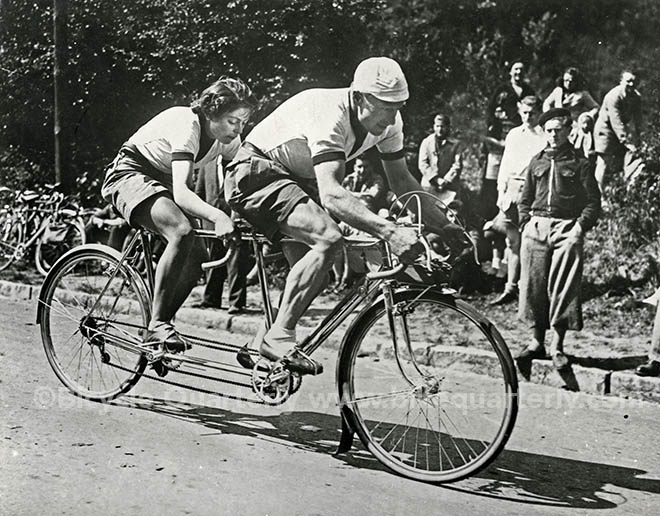
It was in the Poly where Lyli made her mark. For nine years, from 1948 until 1956, she was unbeatable in this tough event. Except when the team crashed in the sharp turn at the bottom of the ultra-fast descent… Lyli broke her collarbone, but that didn’t prevent them from finishing the race in first place – only to be disqualified because their rear fender had broken in the crash. Lyli recalled: “My father then designed his fender reinforcement. He didn’t want that problem to happen again!”
She had many memories from that event: “My best captain was Prestat. He worked as a porteur de presse [newspaper courier]. One year, we set the fastest lap of the day, ahead of the professional racers.” The photo above shows her and Prestat during that record-setting ride, climbing the 14% grade smoothly with a single 46-tooth chainring on the front. And they never even used their largest (22-tooth) cog on the rear!
In 1955, Jean Lheuillot was organizing the first Tour de France Féminin, and he wanted Lyli to be part of the international field. It took some persuading, but he didn’t regret the effort: Lyli won two stages and wore the leader’s jersey for much of the race, before finally finishing fourth overall against accomplished riders like the British stars Beryl French and Millie Robinson. Despite her success, Lyli longed for her days as a cyclotourist: “I always felt more at home with the cyclos. The cutthroat competition of racing wasn’t to my liking.”
The best way to stay out of the fray was to ride off the front, which she did with much success, winning no fewer than eight French championships. She wanted to retire in 1966, but she placed third in that year’s championships. She recalled: “I didn’t want to stop racing after a defeat. […] So I said: ‘Papa, I’d like to give it another try.’ Papa had to make some sacrifices to give me more free time for training and such. That year, I won.”
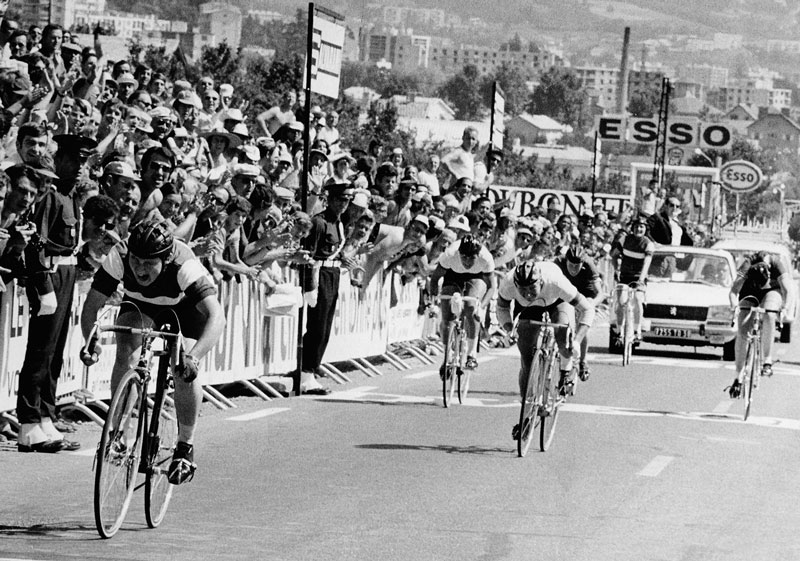
Just before Lyli retired from racing, a few young women asked her if she could coach them. Lyli formed a team that was sponsored by her father. One of the racers, Geneviève Gambillon, told me, “Lyli was a tough master.” Lyli confirmed: “I told them, ‘Training for me starts at 5 o’clock in the morning, because I have to go to the shop afterward.'”
When Gambillon complained about the hard workouts, Lyli told her, “I am 18 years older than you, and I am riding with you, not following in a car behind. If I can do it, so can you!” Lyli’s methods were questioned by the French Cycling Federation, but they brought results: Gambillon won two world championships (above) and more than 20 French championships on road and track.
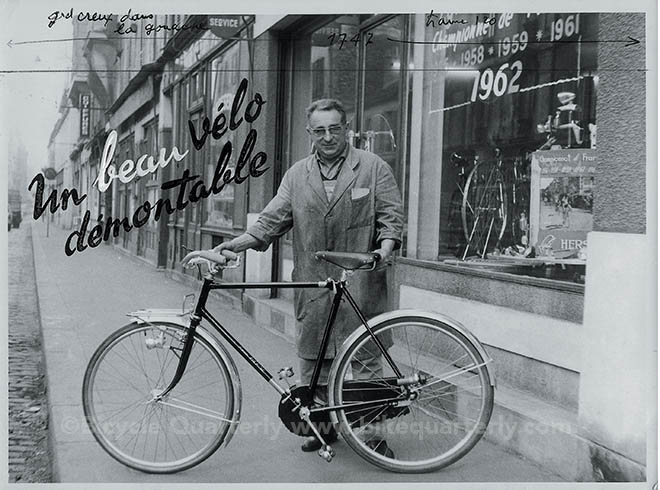
All her adult life, Lyli worked in her father’s shop, shown above in 1962 with Lyli’s first five French championship victories proudly listed on the window (and the prototype of his Démontable take-apart bike). As a teenager, Lyli rode across Paris to pick up parts from distributors. Then she learned to build wheels, and from then on, she was responsible for this important part of the magical bikes her father created. She also ran the shop and distributed Velosolex mopeds on the side to augment the meagre bike sales during the difficult years of the 1960s, when most French dreamed of a car, and not a custom bicycle.
When her father died in 1976, followed a few years later by her mother, she took over. She married Herse’s master framebuilder, Jean Desbois, and together they kept the shop running until 1986. When the word spread that Cycles René Herse was closing, many customers placed orders for one more bike. Lyli and her husband worked for two more years out of the garage of their house until all the orders were filled, and they finally could retire.
I first met Lyli after riding a 1946 René Herse tandem in the 2003 Paris-Brest-Paris. She was delighted that we had continued the legacy she had worked so hard to build. As I visited her many times during the research for my book on her father and his bikes, we became friends, and she asked me to carry the René Herse name forward. I learned from her and her late husband about the machines her father built. We organized annual reunions with the old riders of her father’s team, who also had much information to share.
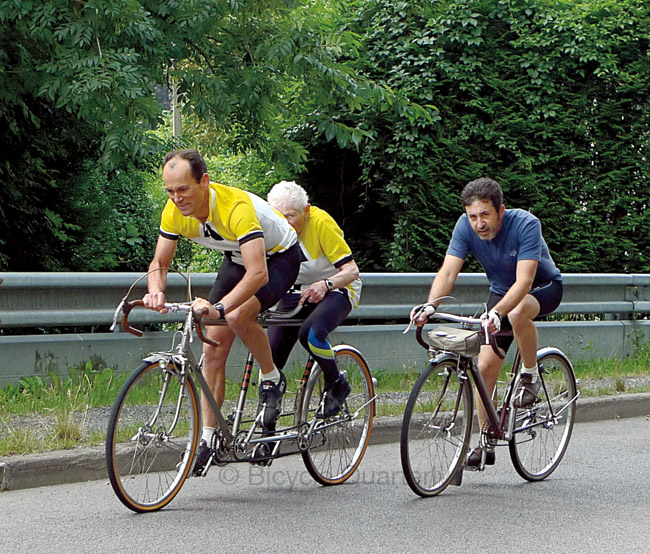
Five years ago, to celebrate her 85th birthday, Lyli asked to ride one more lap of the Poly. We found a René Herse tandem, and I had the honor to pilot her around the course together with a number of riders from her father’s team. I was apprehensive about climbing the famous 14% hill on a tandem with an 85-year-old lady, but Lyli had trained by riding thousands of kilometers on her stationary bike.
On the climb, we dropped all the others, except my friend Christophe, who used to race as an amateur. And even he had to work hard to keep up. The slack upper connecting chain in the photo above says it all: Lyli was contributing more than her share of the power. 14% climbs have rarely felt so easy, and I suddenly could almost imagine how, 55 years earlier, she had ridden eight laps of this difficult course at an average speed of 35 km/h (22 mph).
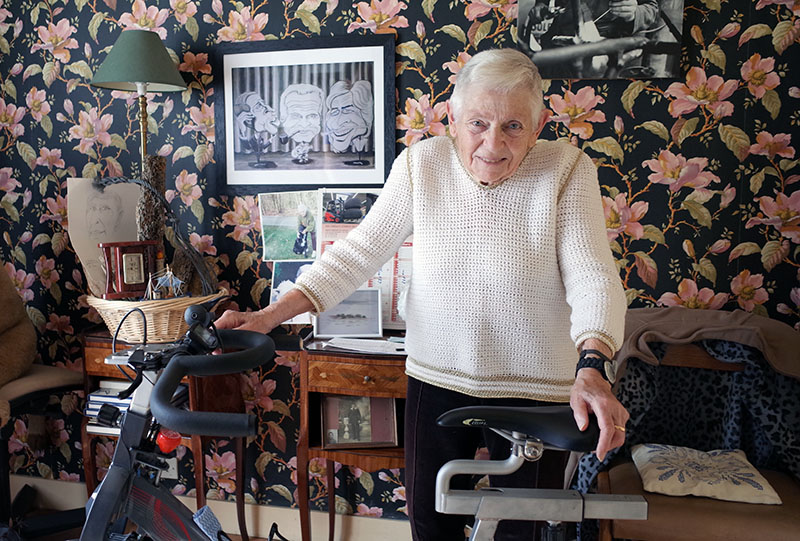
Lyli continued to train every day, and she kept a log of every ride. When I called her on the phone, she was often out of breath: “Excuse me – I was training,” she explained. Always the champion, she wasn’t slowing down even as she approached the age of 90.
I had hoped to go for another tandem ride with her during my next visit – above a ride we took on our René Herse tandem two summers ago. Now Lyli is gone, but she’ll continue to inspire us!


